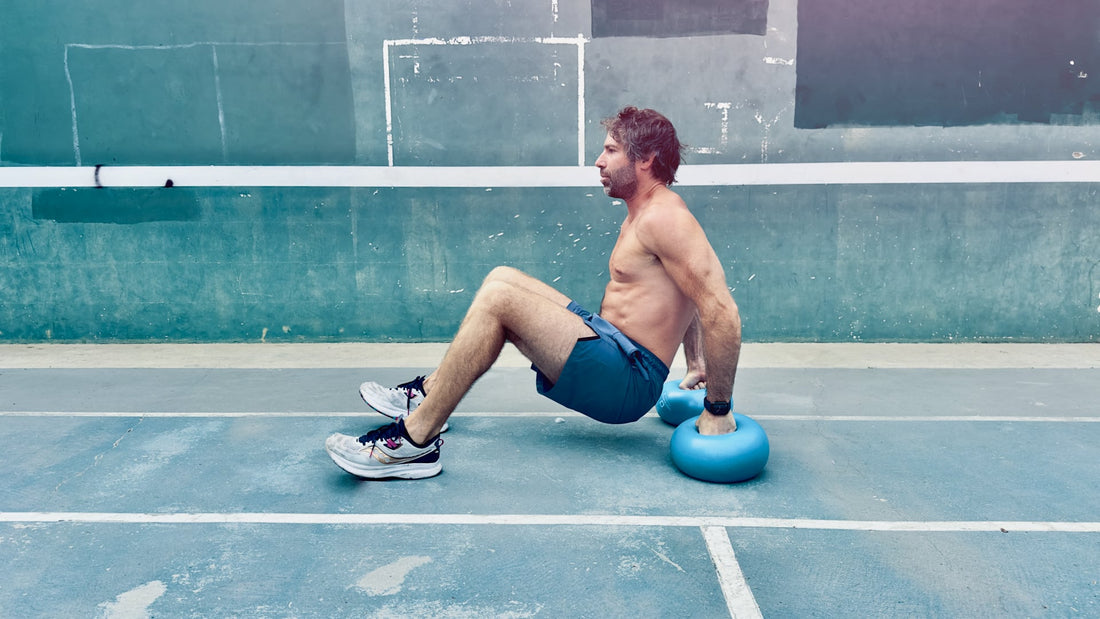
Harnessing the "Reactive Falling Effect" for performance boosting and rehabilitation
Share
Paul-Emmanuel Sornette and Didier Sornette
Abstract: Human bipedalism presents a unique challenge: maintaining stability as an inverted unstable pendulum. The brain develops specialized neural circuits to control this instability, a process that is particularly intense during early childhood, when postural control, locomotion, and cognitive abilities co-develop.
We propose Logic Workout, a training method that leverages this principle by introducing dynamical instability training, stimulating deep neural engagement, proprioception, and reflex adaptation. The induced ``falling effect'' reactivates innate balance mechanisms, compelling real-time motor adjustments. As a result, this method enhances strength, coordination, injury prevention, and cognitive function, providing a science-driven approach to fitness that optimizes both neuromuscular efficiency and brain-body communication.
The Neural Foundations of Movement and Instability
The central nervous system (CNS) in higher animals plays a fundamental role in movement control, planning, and optimization, as movement is our primary means of interacting with and influencing the external world. Among mammals, humans are unique in their permanent bipedalism, which is inherently unstable due to a high center of mass and a narrow base of support. As humans lack stabilizing tails or other anatomical adaptations, maintaining stability requires the precise coordination of sensory inputs (visual, vestibular, and proprioceptive) and motor outputs, managed by specialized neural circuits in the cerebellum, basal ganglia, and motor cortex.
Beyond locomotion, bipedalism frees our hands for high-precision movements, which have shaped human evolution. This suggests a co-evolution of precise movement control and cognitive development, where the brain both adapts to increasingly sophisticated movements and enables more refined motor skills. The ability to manipulate objects with precision has been essential for technological, scientific, and artistic advancements in Mankind's evolution. Effective movement --whether in walking, running, sports, or training-- relies on the interaction of four key components: (i) the CNS (which includes the spinal cord and its reflex pathways), (ii) mechanoreceptors, (iii) endocrine signals from muscles, and (iv) muscles themselves.
Early Development and the Instability Catalyst
In infancy and early childhood, the brain undergoes rapid development to master motor control, learning to stand, walk, run, and perform increasingly complex movements. Humans exhibit an innate startle response to falling (Moro reflex), indicating that the fear of losing balance is hardwired for survival. This period is marked by peak neural plasticity, where the brain rewires itself through sensory-motor experiences. The same mechanisms that support balance and locomotion also facilitate cognitive development, including language, social interaction, and problem-solving. This suggests a synergistic relationship between motor and cognitive functions, reinforcing the idea that movement challenges catalyze brain development.
Recreating Childhood Learning in Adults: The Role of Dynamical Instability
A key question arises: Can adults re-engage the brain's early-state learning capacity by revisiting the fundamental instability challenges of childhood? We propose that training should not only challenge muscles but also reawaken the sensory-motor pathways and cognitive processes involved in movement control, particularly in response to instability and falling. By exposing the brain to dynamical instability, we stimulate the same neural circuits that were critical during early development.
This principle underlies what we call the ``Reactive Falling Effect", where unconscious neural mechanisms for balance control are reactivated. Training designed to elicit controlled falling forces the brain to engage deeply with posture correction, core stabilization, and reflex modulation. This dynamically unstable training pushes the brain into a highly stimulated state, enhancing the connection between movement and cognition. As a corollary, such training should not only improve physical coordination and strength but also enhance cognitive function.
Logic Workout: A Multi-Dimensional Approach Harnessing Rolling, Deformation, and Spring
The “Logic” in Logic Workout derives from positioning your body so that gravity and balance reveal the “truth” of correct form. Poor alignment leads to immediate feedback as the ball rolls away or rebounds. Because the entire body must stabilize, weak points (e.g., shoulder stabilizers, hip abductors) receive targeted training. This built-in “auto-correcting mechanism” helps prevent injuries by addressing imbalances at their root.
Unlike BOSU, rocker boards, TRX, weight training that partially anchor or limit pivot points, Logic Workout stands out in adding complexity and forcing the body to refine its stabilizing strategies.
- Rolling: The ball moves freely around multiple axes, eliminating any single pivot point. Every shift of weight can make the ball “escape” in a new direction, challenging the user’s sensory-motor system.
- Deformation and Contact Patch: The fitball flattens slightly under load, changing the contact area with the floor and your body. This alters friction and rolling behavior on the fly. As weight shifts, the contact patch changes shape, creating a feedback loop that can rapidly magnify minor errors (a hallmark of a system with a high Lyapunov exponent). Deformation also adds degrees of freedom, moving beyond simple rolling to a more complex and unpredictable motion.
- Spring Effect (Elasticity): When compressed, the ball stores elastic energy and rebounds, generating small oscillations. A slight imbalance can trigger a rebound that pushes you back, often overcorrecting posture. This spring effect can enhance instability, demanding continuous micro-adjustments from the nervous system.
By combining these three elements, Logic Workout creates a multi-dimensional instability—a rolling, shape-shifting, bouncing surface that reactivates threat-detection and balance mechanisms.
The threat-detection mechanisms in your nervous system engage automatically when the ball destabilizes. Muscles, ligaments, and fascia coordinate to keep you from falling. Through repeated perturbations, users train their CNS to process proprioceptive, vestibular, and visual cues with precision. In dynamical systems terms, the body learns to “tame” a high Lyapunov exponent environment, effectively bringing order to the inherent chaos.
Logic Workout genesis
In 2006, the first author sustained severe injuries to his right leg and ankle during a snowboarding accident. Despite undergoing two surgical ligament repairs and engaging in three years of physiotherapy (involving BOSU balls, TRX, rocker boards, wobble boards, and specialized machines), his right leg remained 6 cm smaller in circumference than the left, with insufficient strength for routine activities. Faced the grim prospect of requiring a cane for ongoing support, he sought an alternative approach.
Inspired by structural engineering concepts, the first author developed Logic Workout, a training method predicated on Newton’s Third Law (every action has an equal and opposite reaction). Logic Workout integrates classical elements from Pilates, yoga, martial arts and traditional resistance training, but redesigns them to introduce three overlapping instability mechanisms via a small fitball: rolling, deformation, and elastic rebound. This innovative platform magnifies the body’s need for precise force distribution and balance corrections—capturing the essence of the “Reactive Falling Effect.”
Early experiments included placing a chair and using the Swiss ball (approximately chair height) for daily 10-minute sessions; within six months, the injured leg achieved full recovery, surpassing previous strength and flexibility markers.
Paul's (the first author) 60% strength increase in 2.5 months.
During his physiotherapy, Paul maintained a 3.5-hour weekly free-weight routine for his upper body. He had plateaued at 28 kg (62 lb) per arm for 5 repetitions on the bench press. He discontinued free weights entirely for 2.5 months, substituting closed-fist push-ups on the small Swiss ball, feet initially on the floor, then elevated on a chair for a fully horizontal alignment.
Upon tested his aptitude at free weights, he found 28 kg significantly easier, increasing his working set to 45 kg (100 lb) per arm for 5 repetitions—a 60% improvement.
Widespread Success and Applications
Logic Workout has been adopted by a diverse range of individuals, from Olympic champions and athletes of many disciplines to elderly individuals in their nineties with locomotion deficiencies, delivering remarkable outcomes.
One of its most impactful benefits is the alleviation of muscle, ligament, and back pain, as the method strengthens stabilizing structures often neglected in conventional training.
Equally noteworthy are the substantial strength and performance gains reported by practitioners: advanced athletes have broken through plateaus, while others, training as little as 2 hours per week, documented personal records that exceeded their previous achievements under traditional 6-hour weight-training regimens. This fusion of rehabilitation and high-level performance makes Logic Workout a unique, time-efficient tool for a wide array of fitness goals.
Paul's current 2h per week results following the program vs random exercises. Using the small fitball 22cm, Paul's weekly routine consists of a total of 2h per week of Logic Workout. Three sessions of 40 minutes. At 83 kg at 183 cm in height he is able to perform two single-arm pull-ups on each side and 15 single-arm fist push-ups on each side, an achievement typically associated with smaller-framed individuals or those training 10–15 hours weekly via conventional methods.
Conclusion: A Neural Upgrade Through Instability
In essence, Logic Workout revives the deep-learning mechanisms of the brain by reintroducing the “Reactive Falling Effect” under a triad of rolling, deformation, and spring forces. This dynamic instability drives continuous neuromuscular engagement and real-time balance corrections across the entire body. By continually distributing forces and correcting micro-falls, the method creates a high (positive) Lyapunov exponent environment that strengthens prime movers but also fortifies the deep stabilizers and refines the whole-body control that underpins healthy, functional movement.
This method aligns with the universal aspiration for better health and fitness, offering not just physical benefits but also neurological advantages, enhancing strength, endurance, mobility and overall well-being. Logic Workout is not just exercise. It is a neurophysiological upgrade, reconnecting the body with its most fundamental learning processes.








